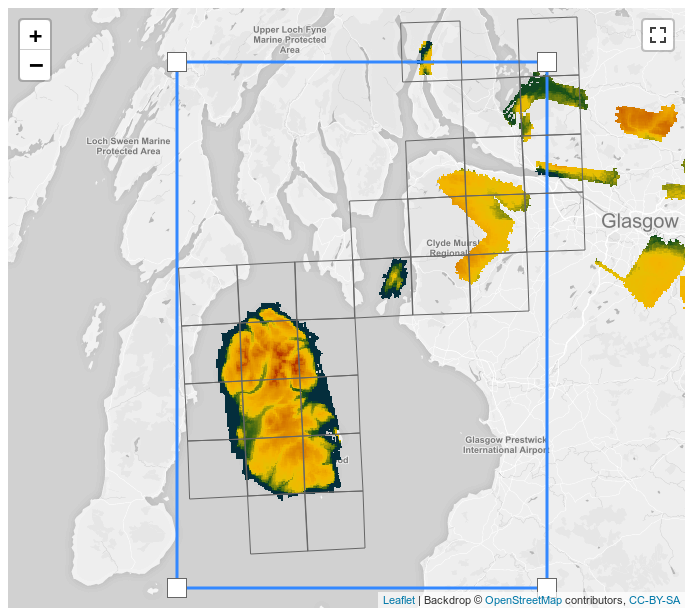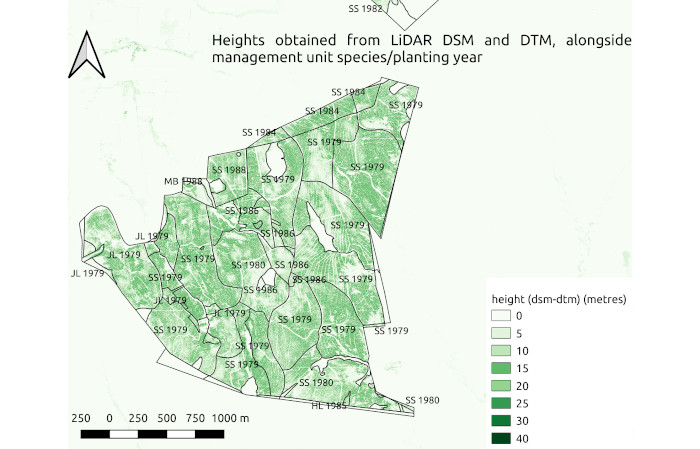Disclaimer: The documents, data and/or models produced here are for interest only and not subjected to formal validation or review. The aim is to explore open data and test its potential in forestry studies. Use at your own risk.
Light detection and ranging (LiDAR) surveys were conducted across Scotland in response to flood risk management, to obtain detailed terrain maps using airborne laser measurements. Those data mainly covered river catchments but included forest blocks from the public forest estate. Therefore it is possible to use the resulting data to determine the heights of trees within those areas. By combining the height data with forest databases it is also possible to explore the growth rate of trees. In this study the aim is to build a height growth model for Picea sitchensis (Sitka spruce) using data from the island of Arran on the west coast of Scotland which was had 100% coverage of LiDAR data from 2014 (figure 1). Height growth models are useful tools for appraising site productivity and can be linked to volume production.

Figure 1: LiDAR data coverage for Arran (Scotland Remote Sensing Portal, 2019)
Height data was derived by downloading the digital surface model(DSM) and digital terrain models (DTM), merging those into a single raster file then subtracting the DTM from the DSM to obtain a height dataset. The Forestry and Land Scotland database was used to obtain management unit shapes, species and planting years. The management unit shapes were extracted for Arran and edge effects removed by applying a negative buffer of 20 metres. The resulting shape file was then populated with maximum heights from the height dataset using zonal statistics in QGIS. Stand age was calculated by subtracting the primary component planting year from the observation year recorded in the LiDAR metadata (figure 2). Maximum heights were assumed to be equivalent to the top height of a stand (i.e. height of 100 trees of greatest diameter).

Figure 2: Derived height data combined with forest data from Forestry Commission Open Data (2019)
Only stands where the primary species was Sitka spruce were included in analysis. Data was also filtered to remove stands of age less than 15, height less than 5 metres or age greater than 80. This allowed the exclusion of data related to regeneration on open space with no planting year and trees on failed sites.
A height model was fitted to the Chapman Richards equation using non linear least squares in R. To test the results the model was compared against a Sitka spruce height growth model developed in Ireland using permanent sample plot data and British yield tables published in James (1982).
A model was successfully fitted to the LiDAR data. The growth trend was calculated for a stand based on a site index height of 27.9m (where site index was taken as top height at age 50). This was visualised alongside a model from Lekwadi et al (2012) in figure 3.

Figure 3: Height growth model for Arran
Table 1: Predicted heights according to site index (SI) (height at age 50). British YC24 results from James (1982) and can be compared to the equivalent site index of 32.5m from the model.
| Age (years) | SI20 | SI25 (m) | SI30 (m) | SI35 (m) | SI 32.5 (m) | YC24 (m) |
| 20 | 11.2 | 14.0 | 16.8 | 19.7 | 18.2 | 14.1 |
| 30 | 15.5 | 19.3 | 23.2 | 27.1 | 25.1 | 22.0 |
| 40 | 18.2 | 22.8 | 27.4 | 31.9 | 29.7 | 28.2 |
| 50 | 20 | 25.0 | 30.0 | 35.0 | 32.5 | 32.5 |
| 60 | 21 | 26.4 | 31.6 | 36.9 | 34.3 | 36.0 |
Table 2: Parameter estimates for Chapman-Richards equation for the Arran model
| b0 | b1 | b2 |
| 29.6633712457551 | 0.0507214987883966 | 1.56876330112201 |
The fitted model produced results comparable with those observed in Ireland over the age range of the data available for fitting. When the model was extrapolated to 100 years the growth in height culminated sooner than both the Irish model and tables published previously for British conditions. The model overestimated height at a given age before age 50 and underestimated height afterwards, compared to both the Irish model in figure 3 and the quoted yield class 24 data from James(1982) in table 1. Given that is it is known (Monumental Trees, 2019) that Sitka spruce can exceed 50 metres in height in less than 100 years in Scotland, the model developed for Arran does not represent long term growth accurately.
Errors could be present in the analysis because not all subcompartments contain sub components of the same age. To simplify the analysis only the first component was considered in determing species and planting year. A detailed sift through the data would be required to understand the effects of this.
LiDAR data cannot detect the traditional definition of a top height tree as it defined in terms of diameter, not height. Whether this is significant in terms of model development in even aged stands requires further exploration and comparison with field based data. Forest data in Arran also lacked balanced representation of age classes due to the period of establishment and felling cycle (figure 3). A general limitation of temporary sample plot approaches is that they can include bias associated with changes in planting stock seed origins, management practices and climate over different growth periods.
It was possible to fit an anamorphic height model for Sitka spruce in Arran using LiDAR data linked to the Forestry and Land Scotland database. The model produced results similar to those in Lekwadi et al (2012) but did not extrapolate well beyond 60 years due to lack of data. A future refinement would be to include measurements from mature stands to better reflect long term growth.
LiDAR Growth models Sitka spruce Picea sitchensis Arran Forestry Scotland